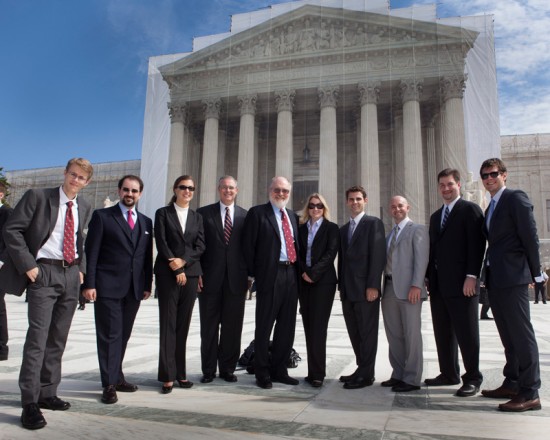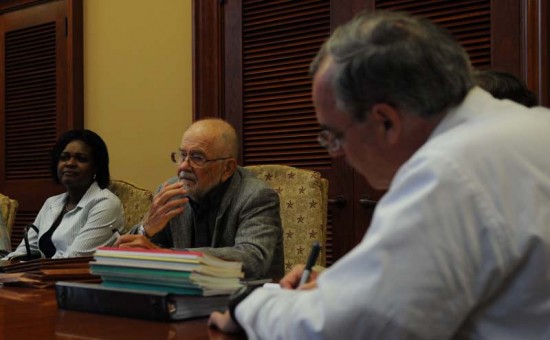
Members of UT Law’s Supreme Court Clinic stand in front of the United States Supreme Court after oral arguments in Lozman v. City of Riviera Beach, Florida on October 1, 2012. Pictured from left to right are Ralph Mayrell, Josh Packman, Alese Bagdol, David Frederick, Michael Sturley, Jill Carvalho, Tyson Lies, Jonathan Levy, Collin White, and Ross Macdonald. (The United States Supreme Court’s iconic facade is currently under renovation. A scrim featuring a full-size photograph of the Court hangs in front of the scaffolding as work continues.)
Faculty and eight students from the University of Texas School of Law’s Supreme Court Clinic traveled to Washington, D.C., to hear oral arguments in one of their current cases, Fane Lozman v. The City of Riviera Beach, Florida, on Monday, October 1, 2012, the opening of the United States Supreme Court’s current term.
The case was argued by David C. Frederick, ’89, codirector of the Supreme Court Clinic and partner at Kellogg, Huber, Hansen, Todd, Evans & Figel PLLC, in Washington, D.C. This was Frederick’s thirty-eighth argument before the Court.

Professors Lynn Blais and Michael Sturley, codirectors of the Supreme Court Clinic, and clinic students discuss strategy for Lozman v. City of Riviera Beach.
The Clinic represents the City of Riviera Beach, Florida, which claims that Lozman’s houseboat was a “vessel” and thereby subject to federal maritime jurisdiction.
Students in the clinic, under the supervision of Frederick, Lynn Blais, and Michael Sturley, worked on the case last spring and this fall. They conducted extensive research on the issues, drafted material that was subsequently included in the merits brief, and helped to prepare for oral argument.
This case is particularly interesting because the petitioner, Fane Lozman, is represented by Stanford Law School’s Supreme Court Litigation Clinic. This marks only the second time that two law school clinics have faced each other in the Supreme Court.

From left to right: Pamala Ryan, City Attorney for the City of Riviera Beach, Florida; Professor David Robertson; and David Frederick, codirector of the Supreme Court Clinic.
Established in the fall of 2006, this is the Supreme Court Clinic’s sixth time representing clients on the merits in the high court. During last year’s term, Clinic students worked on Pacific Operators Offshore, LLP v. Valladolid, in which the Clinic won a unanimous victory on behalf of the widow of a worker killed on the job. In 2010, in Health Care Service Corporation v. Pollitt, the Clinic represented parents in a bad faith claim against their son’s insurance company. That case settled after the Clinic filed its brief on behalf of the parents. In 2008, the Court decided Plains Commerce Bank v. Long Family Land and Cattle Company, an important Indian law case in which the Clinic represented Ronnie and Lila Long, members of the Cheyenne River Sioux tribe. Also in 2008 the Clinic represented three workers seeking to litigate, rather than arbitrate, their age discrimination claims against their employer in 14 Penn Plaza v. Pyett. The Court granted cert in the very first case the clinic took, Altadis USA v. Sea Star Line, but, as in Pollitt, the parties settled before the Court could decide the case. In addition to assisting in the representation of clients in merits cases at the Supreme Court, Clinic students work on cert petitions, briefs in opposition, and amicus briefs at both the cert and merits stages of the Supreme Court litigation process.
Clinic students who worked on the Lozman case include Brad Gray, Josh Packman, Jeff Quilici, and Michael Raupp, all of whom graduated with the Class of 2012; and third-year students Monica Hughes, Ralph Mayrell, Colin Watterson, Jim Weiss, Alese Bagdol, Julia Barrett, Jill Carvalho, Parth Gejji, Jonathan Levy, Tyson Lies, Ross MacDonald, and Collin White.
“The Supreme Court Clinic provides our students with amazing opportunities to get directly involved in advanced appellate litigation,” said Law School Dean Ward Farnsworth. “Very few law schools have anything comparable. David Frederick, Lynn Blais, and Michael Sturley dedicate immense amounts of time to this enterprise, and to providing a gourmet educational experience. I’m proud of everyone involved.”
Related links:
Best Adversaries: Lisa Blatt and David Frederick
Supreme Persuasion: UT Law clinics enjoy remarkable success at the United States Supreme Court
(Photo by Paul Fetters)
